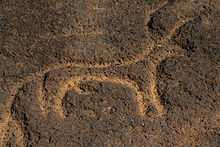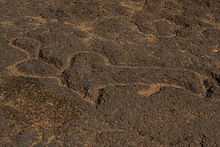Usgalimal rock engravings


Usgalimal rock engravings or Usgalimal Petroglyphs (Konkani: ऊसगाळीमळावयली फातरशिल्पां), at Usgalimal village, in South Goa, is one of the most important prehistoric sites in western India.[1]
Overview
Situated on the banks of river Kushavati, these engravings exhibit earliest traces of human settlement in India. These petroglyphs (rock art) are approximately 20,000 to 30,000 years old and belong to the Upper Paleolithic or Mesolithic eras. More than 100 distinct figures, spread an area of 500 sqm., including images of bulls, labyrinths and human figures are carved on laterite stones.[1][2]
The site was discovered by archaeologists working in the area in 1993, when local villagers took them to the bend in west-flowing river Kushavati outside the village, with mysterious engravings on the laterite shelf. The layer of mud covering up the engravings had been washed away by monsoon floods facilitating their discovery. Subsequently when the soil was cleared more engravings were found. In the coming years, Archaeological Survey of India (ASI) put up signage and started promoting the site as a tourist destination, while the Forest Department declared it a protected area. Some of the finds are displayed in the Panaji Archaeological Museum.[3]
Location
The engravings are situated on the bed of the river Kushavati, beyond old iron ore mines, outside Usagalimal village, accessible via a winding pathway. It is about one km down from the main road between Rivona to Neturlim, and about 16 km south of Rivona in the Sanguem taluka in South Goa district.[4][5]
References
- ↑ 1.0 1.1 Indian Archaeological Society (2006). Purātattva, Issue 36. Indian Archaeological Society. p. 254.
- ↑ Kalyan Kumar Chakravarty, Robert G. Bednarik, Indirā Gāndhī Rāshṭrīya Mānava Saṅgrahālaya (1997). Indian rock art and its global context. Motilal Banarsidass Publ.,. pp. 228 pages (see page 34). ISBN 81-208-1464-9, 9788120814646 Check
|isbn=value (help). - ↑ David Abram (2004). Goa. Rough Guides. p. 190. ISBN 184353081 Check
|isbn=value (help). - ↑ "Historical rock art included in unauthorized religious structures list". The Times of India. Mar 15, 2010.
- ↑ Paul Harding (2003). Goa. Lonely Planet. p. 187. ISBN 1-74059-139-9.